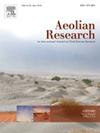Origin and late pleistocene to early holocene activity of albany pine bush dune field, New York, northeastern USA
IF 3.4
3区 地球科学
Q2 GEOGRAPHY, PHYSICAL
引用次数: 0
Abstract
Well-preserved stabilized parabolic dunes occur in the Albany Pine Bush (APB), New York State, northeastern USA. This area was glaciated by the Laurentide Ice Sheet (LIS) and subsequently inundated by glacial Lake Albany until ∼ 13.0 ka. Glaciofluvial and glaciolacustrine deposits provided source sediments for dunes, which migrated towards the east-southeast. This integrated study addresses the morphology, grain mineralogy and micromorphology, stratigraphy, and chronology of a stabilized parabolic dune in the APB. The dune was active from 12.5–11.0 ka and was formed from locally-derived fluvial sediments that are slightly older (ca. 13.3–12.5 ka). The dune sands and underlying fluvial sediments are both texturally and mineralogically similar. Micromorphological analyses indicate that the dune quartz grains exhibit few characteristics typical of eolian transport, but inherently retain features of subaqueous origin. Consequently, both the distance and the duration of eolian transport during dune construction were very short. Dune stabilization coincided with the end of the Younger Dryas coeval with a forest transition from spruce (Picea) to pine-oak (Pinus-Quercus). The well-preserved morphology of dunes, and an absence of paleosols and stratigraphic truncations, all support dune stability throughout the Holocene, even with recurrent wildfire to which the local ecology has adapted.
美国东北部纽约奥尔巴尼松丛沙丘场的起源及晚更新世至全新世早期的活动
美国东北部纽约州奥尔巴尼松林(Albany Pine Bush, APB)中存在保存完好的稳定抛物状沙丘。该地区被劳伦泰德冰盖(LIS)覆盖,随后被奥尔巴尼冰川湖淹没,直到约13.0 ka。冰川河川和冰川湖沉积为沙丘提供了物源沉积物,沙丘向东-东南方向迁移。这项综合研究解决了APB稳定抛物面沙丘的形态,颗粒矿物学和微观形态,地层学和年代学。沙丘活动时间为12.5 ~ 11.0 ka,由本地河流沉积物形成,时间稍早(约13.3 ~ 12.5 ka)。沙丘砂和下伏的河流沉积物在结构和矿物学上都相似。微形态分析表明,沙丘石英颗粒几乎没有典型的风成搬运特征,但本质上保留了水下成因的特征。因此,沙丘形成过程中风沙运移的距离和持续时间都很短。沙丘的稳定与新仙女木时期的结束同时发生,森林从云杉(云杉)向松橡树(松-栎)过渡。沙丘的形态保存完好,古土壤和地层截断的缺失,在整个全新世都支持沙丘的稳定性,即使当地生态已经适应了周期性的野火。
本文章由计算机程序翻译,如有差异,请以英文原文为准。
求助全文
约1分钟内获得全文
求助全文
来源期刊

Aeolian Research
GEOGRAPHY, PHYSICAL-
CiteScore
7.10
自引率
6.10%
发文量
43
审稿时长
>12 weeks
期刊介绍:
The scope of Aeolian Research includes the following topics:
• Fundamental Aeolian processes, including sand and dust entrainment, transport and deposition of sediment
• Modeling and field studies of Aeolian processes
• Instrumentation/measurement in the field and lab
• Practical applications including environmental impacts and erosion control
• Aeolian landforms, geomorphology and paleoenvironments
• Dust-atmosphere/cloud interactions.
 求助内容:
求助内容: 应助结果提醒方式:
应助结果提醒方式:


